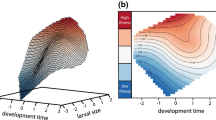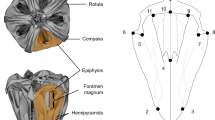Abstract
Given that characters exhibiting macroscopic asymmetry have evolved in a wide variety of taxa, heritable variation for bilateral asymmetry must have arisen at some point in their history. The recognition that heritable variation may underlie some statistical asymmetries not only raises concerns about the incautious use of statistical estimates of FA in studies of developmental stability, but it suggests some intriguing questions about the possible evolutionary origins of macroscopic asymmetries. First, we developed an additive model of bilateral variation based on some simple assumptions about the developmental control of bilateral variation. Second, using a new approach for studying statistical asymmetries, we conducted an analysis of bilateral variation in eight metrical traits of a harpacticoid copepod (Tigriopus californicus) to search for novel forms of statistical asymmetries. The model we developed revealed three independent statistical asymmetries of potential evolutionary significance:a) a previously unrecognized form of asymmetry (referred to here asnormal covariant asymmetry),b) antisymmetry, andc) directional asymmetry. Because each pattern of variation would seem to require different amounts and kinds of developmental-genetic information [a- only negative feedback between sides (bilateral inhibition),b- bothbilateral inhibition and average departure from symmetry (bilateral offset),c- bilateral inhibition, bilateral offset, and a consistent overdevelopment of one side or the other (side-bias control)], those requiring less information would seem more likely to represent earlier stages in the evolution of macroscopic asymmetries. Our analysis of bilateral variation inTigriopus revealed no evidence for any form of statistical asymmetry other than fluctuating asymmetry. However, a significant positive covariation between sides, even after correction for body size variation, suggested that factors influencing relative limb length (whether genetic or environmental) affected both sides equally rather than one side at the expense of the other. Finally, we note that certain statistical asymmetries (directional asymmetry, any form of covariant asymmetry) may render characters unreliable for estimating developmental stability because, unlike pure fluctuating asymmetry, they may signal a genetic component to asymmetry variation.
Similar content being viewed by others
References
Allendorf, F. W. & R. F. Leary, 1986. Heterozygosity and fitness in natural populations of animals, pp. 57–76 in Conservation Biology. The Science of Scarcity and Diversity, edited by M. E. Soulé. Sinauer Assoc., Inc., Sunderland, MA (USA).
Brown, N. A. & L. Wolpert, 1990. The development of handedness in left-right asymmetry. Development 109: 1–9.
Burton, R. S., 1987. Differentiation and integration of the genome in populations of the marine copepodTigriopus californicus. Evolution 41: 504–513.
Burton, R. S. & M. W. Feldman, 1981. Population genetics ofTrigriopus californicus. II. Differentiation among neighboring populations. Evolution 35: 1192–1205.
Clarke, G. M., G. W. Brand & M. J. Whitten, 1986. Fluctuating asymmetry: A technique for measuring developmental stress caused by inbreeding. Austr. J. Biol. Sci. 39: 145–153.
Govind, C. K., 1981. Does exercise influence the differentiation of lobster muscle?, pp. 215–253 in Locomotion and Energetics in Arthropods, edited by C. F. Herreid & C. F. Fourtner. Plenum Pr., New York.
Kindred, B., 1965. Selection for canalization in mice. Genetics 55: 635–644.
LaBarbera, M. L., 1989. Analyzing body size as a factor in ecology and evolution. Ann. Rev. Ecol. Syst. 20: 97–117.
Leamy, L. & W. Atchley, 1985. Directional selection and developmental stability: evidence from fluctuating asymmetry of morphometric characters in rats. Growth 49: 8–18.
Leary, R. F. & F. W. Allendorf, 1989. Fluctuating asymmetry as an indicator of stress in conservation biology. Trends Ecol. Evol. 4: 214–217.
Levin, D. A., 1970. Developmental instability and evolution in peripheral isolates. Amer. Nat. 104: 343–353.
Lewontin, R. C., 1974. The analysis of variance and the analysis of causes. Am. J. Human Genet. 26: 400–411.
Lewontin, R. C., 1983. Gene, organism and environment, pp. 273–285 in Evolution from Molecules to Men, edited by D. S. Bendall. Cambridge Univ. Press, New York, NY.
Ludwig, W., 1932. Das Rechts-Links Problem im Tierreich und beim Menschen, Springer, Berlin. 496.
Mackay, T. F. C., 1980. Genetic variance, fitness, and homeostasis in varying environments: an experimental check of the theory. Evolution 34: 1219–1222.
Mather, K., 1953. Genetical control of stability in development. Heredity 7: 297–336.
McKenzie, J. A. & G. M. Clarke, 1988. Diazinon resistance, fluctuating asymmetry and fitness in the Australian sheep blowfly,Lucilia cuprina. Genetics 120: 213–220.
Mellon, D. F. & P. T. Stephens, 1978. Limb morphology and function are transformed by contralateral nerve section in snapping shrimp. Nature 272: 246–248.
Mitton, J. B. & M. C. Grant, 1984. Associations among protein heterozygosity, growth rate, and developmental homeostasis. Ann. Rev. Ecol. Syst. 15: 479–499.
Neville, A. C., 1976. Animal Asymmetry. Arnold (Inst. Biol. Stud. Biol.), London. 60.
Palmer, A. R. & C. Strobeck, 1986. Fluctuating asymmetry: measurement, analysis, patterns, Ann. Rev. Ecol. Syst. 17: 391–421.
Palmer, A. R. & C. Strobeck, 1992. Fluctuating asymmetry as a measure of developmental stability: Implications of non-normal distributions and power of statistical tests. Acta Zool. Fenn. 191: 57–72.
Parsons, P. A., 1990. Fluctuating asymmetry: An epigenetic measure of stress. Biol. Rev. 65: 131–145.
Provasoli, L., K. Shiraishi & J. R. Lance, 1959. Nutritional idiosyncrasis ofArtemia andTigriopus in monoxenic culture. Ann. N.Y. Acad. Sci. 77: 250–261.
Rendel, J. M., 1967. Canalization and Gene Control. Academic Pr., New York, NY (USA).
Ross, K. G. & J. L. Robertson, 1990. Developmental stability, heterozygosity, and fitness in two introduced fire ants (Solenopsis invicta andS. richteri) and their hybrid. Heredity 64: 93–103.
Shapiro, S. S., M. B. Wilk & H. J. Chen, 1968. A comparative study of various tests for normality. J. Amer. Stat. Assoc. 63: 1342–1372.
Sokal, R. R. & J. F. Rohlf, 1981. Biometry. Freeman, San Francisco, CA. 859.
Timoféeff-Ressovsky, N. W., 1934. Über der Einfluss des genotypischen Milieus und der Aussenbedingungen auf die Realisation des Genotypes. Mach. Ges. Wiss. Göttingen, Math.-Physik. Klasse, Fachgruppe 6 1: 53–106.
Van Valen, L., 1962. A study of fluctuating asymmetry. Evolution 16: 125–142.
Waddington, C. H., 1957. The Strategy of the Genes. George Allen Unwin, London.
Wright, S., 1920. The relative importance of heredity and environment in determining the piebald pattern of guinea pigs. Proc. Natl. Acad. Sci. USA 6: 320–332.
Zakharov, V. M., 1989. Future Prospects for Population Phenogenetics. Harwood Academic Publishers GmbH, New York. 79.
Zakharov, V. M., 1992. Population phenogenetics: Analysis of developmental stability in natural populations. Acta Zool. Fenn. 191: 7–30.
Author information
Authors and Affiliations
Rights and permissions
About this article
Cite this article
Palmer, A.R., Strobeck, C. & Chippindale, A.K. Bilateral variation and the evolutionary origin of macroscopic asymmetries. Genetica 89, 201–218 (1993). https://doi.org/10.1007/BF02424514
Received:
Accepted:
Issue Date:
DOI: https://doi.org/10.1007/BF02424514




